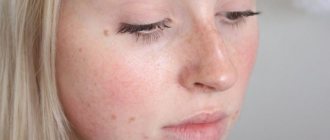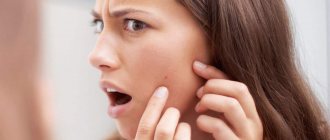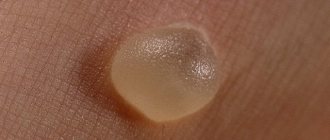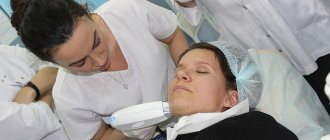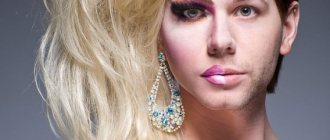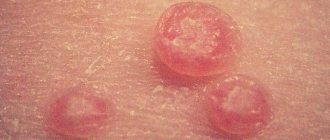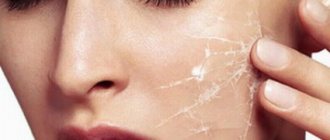Causes of allergies on the face
Remember! There are a large number of factors that contribute to the appearance of allergies, so sometimes it is necessary to use many methods to diagnose the pathology. Allergic reactions on the face are similar to a number of infectious diseases.
Allergy is the resistance of the immune system to the release of free histamine. Each person's skin reacts individually to the organic compound histamine, the biological substances of which act primarily as an irritant to the upper layer of the skin.
After a certain amount of time (it’s different for everyone), allergy symptoms appear. The symptoms of pseudoallergy are similar to the symptoms of true allergy, but the immune system is not involved.
Factors contributing to facial allergies:
- exposure to low temperatures, air, heat, ultraviolet rays;
- products with high concentrations of allergens;
- long-term use of potent medications - antibiotics, analgesics;
- pollen grains of highly allergenic plants, accumulation of mold spores, waste products of pets, dust;
- cosmetics whose composition is not suitable for some people due to their skin type;
- the influence of a severe psycho-emotional state, environmental pollution, genetic predisposition;
- abuse of deep cleansing of the facial skin - the upper layers of the skin become thinner, which leads to sensitization of the epidermis to the irritant.
Important! According to ICD-10, allergies on the face are assigned the number L-20-L-30 (Dermatitis and eczema).
Experts distinguish:
- Types of allergic reactions, that is, what contributed to the allergy - consumer products, medications, contact with an allergen and other reasons;
- Allergic manifestations - rash, peeling, itching, burning, redness, pimples on any part of the facial skin (forehead, cheeks, chin, bridge of the nose and even neck).
Allergic rashes on the face in an adult
Causes of allergic rash
To find out the causes of the disease, the patient is sent for a diagnostic examination. You need to take allergy tests. This research is carried out in a laboratory.
To conduct the analysis, the doctor damages the patient’s skin and takes a scraper from the upper layer of the epidermis.
The allergen is applied to this area, and the resulting material is taken for laboratory testing.
They continue to observe the body’s reaction to the introduced allergen. If the area becomes red, swollen, or swollen, the acne is caused by this allergenic irritant.
Several allergens cause irritation in humans. Based on this, doctors make a test and divide the allergens into several types.
The appearance of pimples due to allergies - what do they look like, how do they differ from acne?
It is often believed that a face with acne is the lot of teenagers. There is a reason for this, because the transition period is just the time for comedones to flourish on the face and body, thanks to the action of testosterone. Since this hormone is capable of turning teenagers into adults, it stimulates any chemical processes occurring in the body and causes acne to form. Testosterone is also part of our lives, and its main influence is visible in the work of the sebaceous glands throughout the body. The latter's receptors are very susceptible to the described hormone. It contributes to the production of sebum under its influence, or in other words, sebum, which is involved in the direct appearance of acne. This concept is associated with the direct hydration and protection of the skin from unpleasant carriers. Sebum is produced in sufficient volume and easily self-disqualifies when washed. Due to the significant accumulation of sebum on the skin surface, the exfoliation process is inhibited. Sebum mixes with keratinized scales, forming a kind of shell on the epidermis. Due to its “imprisonment” in the skin, a new amount of sebum gets stuck inside the pores, thereby forming a sebaceous plug. The latter undergoes oxidation with oxygen exposure and transforms into a blackhead - a blackhead.
The sebaceous plug is a great place for bacteria. It absorbs its contents, and acne turns into pimples, or inflammation of a superficial nature.
Classification of allergic reactions
Allergies in adults and children can occur for various reasons. At the moment when the immune system begins to fight the irritant, it is difficult to determine what contributed to the allergic reaction.
Allergic reactions are divided into:
- instantaneous - a dangerous type of allergy, characterized by the immediate onset of allergic symptoms. The reaction is observed several minutes to half an hour after interaction with the allergen;
- delayed - symptoms are noticed after a few hours - two, three days. A distinctive feature of the allergic reaction is pale, small rashes, usually with mild itching - a consequence of cumulative allergies.
Allergic acne on the face photo
Why does the face suffer from allergic rashes?
The skin on the face most often becomes covered with allergic rashes as a result of the following:
- The largest number of allergens are found in our environment. By inhaling the allergen along with the air, the nose is exposed to the first attack of the allergen, and accordingly, rashes will most quickly appear on the face.
- When eating foods containing an allergen, the mouth and lips are involved in the initial contact, which also causes the appearance of rashes.
- Cosmetics that are applied directly to the face come into direct contact with it.
- The face is open, it cannot be protected by clothing like the body, hence the greater risk of the allergen getting on it.
Causes of allergic acne
Almost any allergens can lead to the appearance of such rashes; much here depends on the individual characteristics of the body, but there is also a list of products and substances that most often act as provocateurs of an allergic reaction. These include:
- Citrus and exotic fruits;
- Seafood;
- Cereal gluten;
- Dairy products for lactose intolerance;
- Chocolate and cocoa;
- Confectionery;
- Sweets;
- Eggs;
- Nuts;
- Spices and seasonings;
- Pollen and green mass of plants and flowers;
- House and street dust;
- Alcohol and alcoholic beverages;
- Tobacco smoke;
- Metals;
- Cosmetics, including creams, lotions, shampoos, soaps and shower gels;
- Medications;
- A variety of household chemicals.
Allergy symptoms on the face
Allergic symptoms are directly related to the location and type of allergy.
Article on the topic: Allergy to eyelash extensions, how to look beautiful in everyday life?
The main symptoms of allergies on the face:
- rashes of various types - spots, pustules, papules, blisters, scales, erosions;
- swelling, swelling of the face;
- redness.
Primary and secondary signs of an allergic reaction
At the initial stage of allergies on the skin of the face, the following are formed:
- pustules - small cavity formations with pus inside, which subsequently burst with further scarring of the tissue;
- papules are small red bumps, the size of which varies from 3 to 30 mm. Papules disappear without a trace after treatment;
- vesicles - a ball-shaped rash filled with liquid exudate - transparent or with blood impurities. Often formed during severe inflammatory process on the skin;
- blisters are defined, swollen rashes with liquid inside, they itch very much, and the skin of the face swells.
Allergic symptoms taking into account the location of the lesion
In most cases, allergy symptoms appear for specific reasons. So, redness can be observed on the chin, cheeks, and forehead. But there are some peculiarities.
A rash usually does not appear in the eyes, but swelling, redness, lacrimation appears, and the mucous membrane becomes inflamed. The lips are also mucous membranes, like the eyes, so rashes are rare, and with an individual reaction on the inside of the lips, patients complain of blisters. Also, the lips become swollen, and the tingling sensation does not stop until the allergy subsides.
Allergies in the ears are manifested by severe redness and itching, which leads to flaking. Most often, an allergic reaction to the ears is a consequence of contact dermatitis or food allergies.
What to do if you have an allergy on the face, severe swelling
Provoking factors
Allergies in the form of acne can be triggered by the following factors:
- cosmetical tools;
- medicines;
- plant pollen;
- insect bites;
- hyperhidrosis.
Acne on the face can sometimes occur due to incompatibility of the skin with one or another cosmetic. Cream, powder, foundation and even gel for washing can provoke a reaction. If you have not previously had problems with your skin, then the answer to the question of whether it is acne or an allergy will be obvious. Most likely, you will simply need to abandon the new cosmetic product and replace it with another.
Medications can also be the culprit for the appearance of rashes not only on the face, but on all areas of the skin. At the same time, acne on the body itches and becomes very itchy. This reaction can also be provoked by food, as well as household chemicals in the form of washing powder, rinse aid, etc.
Plant pollen also often acts as a provocateur for a rash.
An allergic pimple may well be caused by an insect bite; this type of skin irritation also requires mandatory treatment.
Facial allergies can also occur due to excessive sweating. Some people suffer from such a rather rare disease as sweat allergy. During the hot season, this category of patients suffers from acne not only on the face, but throughout the body.
There is also such a thing as an allergy to cold, which is also characterized by the appearance of a rash on the skin.
Before proceeding with therapy, the true cause of acne should be determined. A specialist should help you distinguish acne from allergies and prescribe adequate treatment.
There are many reasons for acne
How to cure allergic dermatosis?
What should be done to reduce the effect of an irritating or sensitizing substance on the body? It is imperative to exclude it from the patient’s diet and environment. Eliminating provoking factors will immediately reduce the risk of new acne, and existing ones will gradually disappear.
The formation of an allergic rash on the body in most cases is associated with an unfavorable interaction of the body with external factors and internal diseases. The skin suffers from gastrointestinal pathologies and stress. Ultraviolet rays and extreme temperatures have a negative effect on the epidermis. The body cover should be protected from any adverse factors.
Treatment of allergic pimples in children
Treatment procedures in children should begin immediately when the first symptoms appear!
Acne will not go away on its own. It is preferable to feed a small child hypoallergenic breast milk. Completely eliminate cow's milk from his diet and opt for fermented milk products (if you are breastfeeding, you should do the same). Start giving the first complementary foods in small portions, giving the body the opportunity to get used to the new type of food. Ideally, it is better to start complementary feeding with vegetables and gradually move on to cereals. Be very careful about vaccinations; consult your pediatrician about the choice of antiallergic drugs for your baby. To relieve irritation on children's skin, baths with string and wheat bran are perfect. If a child develops a weeping rash, you can add a low concentration of oak bark decoction to the bath. But it is necessary to ensure that the treatment does not aggravate existing symptoms.
Allergy treatment
Important! Before treating facial allergies, you should consult your doctor. Self-therapy leads to irreversible consequences and complications.
Allergy treatment is provided depending on the speed of the reaction. Therapeutic methods for treating different types of allergies differ from each other. Fulminant and delayed types of allergies are treated differently.
Lightning type
Quincke's edema is a severe allergic reaction, the symptoms of which appear instantly and do not require delay or self-medication. You should immediately call a rescue team, and before the ambulance arrives, it is advisable to take an antihistamine to help relieve swelling.
In case of acute allergies, help will be provided by Suprastin, Tavegil, Diphenhydramine, Erius, Claritin, Cetrin, Fexadin and other medicines, at least one of them should preferably be stored in a home medicine cabinet.
Attention! Allergic Lyell's syndrome is characterized by an immediate course. Blisters quickly form on the skin of the face and other parts of the body, which burst, and the epidermis becomes covered with erosions. An allergic reaction is accompanied by high body temperature, and if you do not call an ambulance as soon as possible, death is possible.
Facial allergy Quincke's edema
Slow type
With a slow type of allergy, the processes occur sequentially and slowly. Typically, red spots appear on the face, which subsequently begin to itch and cause discomfort. The itching and redness are accompanied by a rash on the cheeks, chin and nasolabial triangle.
The sequence of actions for a patient suffering from a delayed type facial allergy:
- Determine the cause contributing to the irritation and allergic reaction. It is advisable to remember what you ate, drank, what medications you took recently, petted someone’s cat, came into contact with synthetic fabrics, etc.;
- Limit contact with the allergen - if you neglect this rule, the allergy will move from the acute stage to the chronic stage;
- Before visiting a doctor, wipe your face with a cotton pad soaked in a decoction of chamomile, calendula, string, and sage. The herbal decoction has an antiseptic and sedative effect;
- Make a compress using boric acid. Dilute 1 tsp. a glass of water and periodically apply moistened gauze to your face;
- Take an antihistamine - the sooner the substance begins to fight allergies, the faster the symptoms will go away;
- Visit an allergist or dermatologist, who will diagnose allergies using proven methods and then choose treatment tactics.
Note! Treatment depends on the severity of the allergic process.
Eczema on the face After collecting anamnesis and tests, the doctor prescribes treatment for allergies on the face. Therapy is most often complex and may consist only of oral or local medications. The process of curing allergies consists of the following methods:
- restoration of the immune system;
- removing allergens from the body and purifying the blood;
- antihistamines.
Ways to treat allergic acne
Treatment of acne and allergies must be carried out comprehensively - it is difficult to cope with this problem with local medications alone. External signs of the disease may disappear for a while and then reappear. At the initial stage of the disease, when the skin begins to turn red, it should be carefully wiped with cotton swabs soaked in a solution of boric acid. A weak brew of green tea is also suitable for this procedure.
Antihistamines are quite effective in combating acne breakouts.
A positive effect can be obtained from applying lotions from a decoction of chamomile or chamomile. For the same purposes, lotion with salicylic acid is used. When the itching disappears, the affected areas can be lightly sprinkled with potato starch.
If an allergy manifests itself in the form of acne, the doctor may prescribe an ointment, for example, Gistan or Fenistil-gel. In the chronic stage of the disease, an ointment containing hormones, Lorinden S, is applied to the skin.
If acne on the body itches, then in addition to topical medications, treatment is carried out with antihistamines. This could be Diazolin or Suprastin, 1 tablet per day.
To eliminate drowsiness during the day and delayed reaction, Diphenhydramine or Tavegil is prescribed at night. Another effective drug that does not cause adverse reactions is Claritin, which is also taken 1 tablet per day.
If the disease is not very severe, the doctor may prescribe non-hormonal medications for external use. For more complicated cases, hormonal ointments and combination medications will be required. To remove toxins formed in the body during allergies, the doctor prescribes activated carbon, Enterosgel or other absorbents. It is better for women to refrain from using decorative cosmetics during treatment.
As an addition to the main therapy, after consultation with the doctor, treatment with folk remedies can be carried out. You can prepare decoctions of chamomile, string or calendula and wipe the affected areas of the skin with them. Instead of medicinal herbs, you can use weak tea leaves.
An effective remedy is a decoction of bay leaves. To prepare it, you will need to pour about 5 leaves with a glass of water and cook over low heat for about 20 minutes.
If pimples appear all over the body, they can be treated with a bath. Add a glass of potato starch or oatmeal to the water. After 10 minutes in such a bath, the patient’s condition improves significantly. You can also sprinkle potato starch on clean, dry skin.


